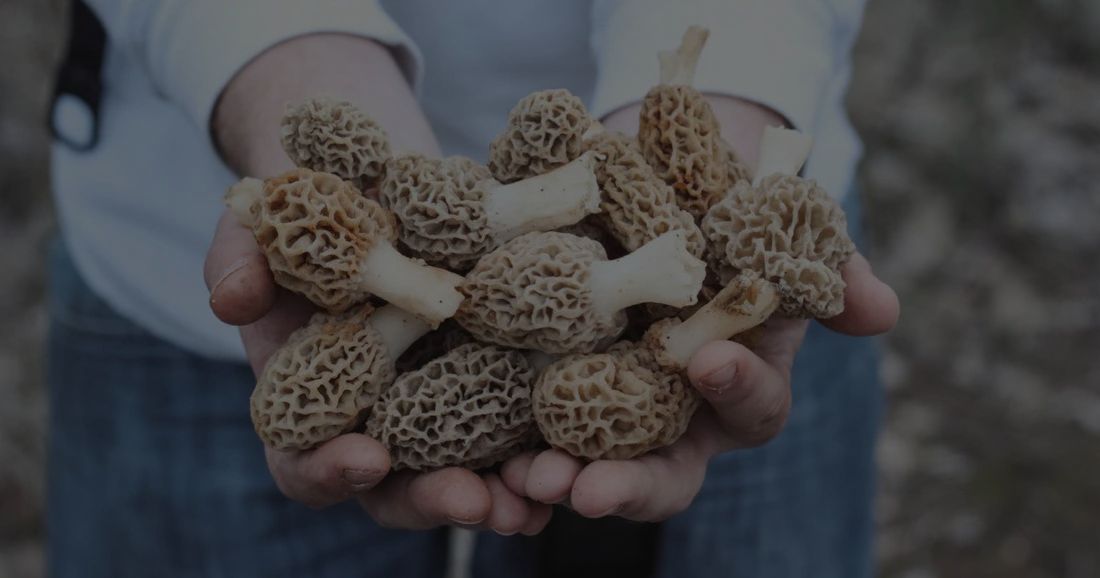
Known for their unique honeycomb-like appearance and distinct earthy or meaty flavor, Morel Mushrooms (Morchella spp.) are one of the most popular edible mushrooms you can grow at home. These mushrooms come under the Fungi Kingdom and can’t be considered plants, as they don’t have roots or seeds.
Finding and identifying mushrooms is a fun hobby for many foragers. But if you want to grow morel mushrooms and enjoy them at home, this guide will help you.
By mimicking their natural habitat at home, you can easily grow these mushrooms. Usually not recommended for beginners due to low success rate and unpredictable growth, you can still try growing morel mushrooms, and with enough patience and luck, you’ll be able to enjoy them at home.
So without further ado, let’s explore how to grow morel mushrooms at home.
How To Grow Morel Mushrooms?

Selecting Location
You can choose to grow morel mushrooms indoors and outdoors. Here’s how to grow them –
- Outdoors – Naturally occurring morels can be found in damp, dark woodlands, frequently close to ash, elm, apple, or oak trees. When selecting a position outside, look for a somewhat shaded area that will stay cool all spring long and defend against strong winds. To avoid water stagnation, the bed should have adequate drainage and, if at all feasible, be slightly sloping.
- Indoors – Morel mushrooms can be grown indoors in raised beds or deep trays for those lacking access to appropriate outdoor growing conditions. Put the containers under artificial grow lights or next to indirect sunlight, such as a window facing north. Although it is more work, growing inside gives you more control over humidity and temperature.
Soil Preparation
Start by excavating the space or filling containers with loamy, neutral to slightly acidic (pH 6.5–7.5) soil that drains well. If unsure, use a home kit to test the pH of the soil and modify with sulfur or lime as necessary. improve large amounts of leaf mold or organic compost; these improve moisture retention and vital nutrients.
Morels thrive in post-fire conditions that are rich in nutrients. Add a couple handfuls of agricultural gypsum and a thin layer of clean wood ash to mimic this. Wood ash enhances minerals often found in forest soil following lightning strikes or fires, whereas gypsum increases accessible calcium, which promotes mycelium growth.
Add chopped bark, decomposed leaves, and wood chips from fruit trees or hardwoods. This resembles how morels organically colonize forest litter, which feeds the developing mycelium. Steer clear of coniferous (pine) chips since their resins can prevent the formation of fungi.
Planting
Morel mushrooms can be grown from spawns or spores, both methods require different skills. Here’s the difference between growing morels from spawns and spores –
- Spawns – Buying readymade morel spawn from reputable providers is the most dependable method of starting a morel patch. Grain, sawdust, or plug media injected with morel mycelium are the usual forms of spawn. Make sure the supplier you choose has a track record of performance in your climate.
- Spores – By gathering ripe wild morels, adventurous growers occasionally make a spore slurry, which is a mixture of morel spores, water, molasses, and salt. Results may differ depending on the availability of fresh, viable spores and the right soil conditions, but the slurry is poured over a prepared bed.
Once you’ve decided whether to grow morel mushrooms from spawns or spores, you can start planting them –
- Spread the spawn or spores: Cover the prepared substrate with an even layer of spawn or spore slurry.
- Incorporate spawn: To guarantee direct contact with organic materials, lightly rake or press the spawn into the soil’s surface. Since morel mycelium grows on the surface, avoid burying it too deeply.
- Casing layer: Apply a thin layer of damp peat moss, compost, or leaf mold (1–2 cm). This protective outermost layer provides nutrients gradually and aids in humidity retention.
Morel Mushrooms Care

Temperature and Humidity
Keep a close eye on the air and soil temperatures. Until soil temperatures are at least 9–13°C (48–56°F) and daytime air temperatures remain between 13–16°C (55–61°F), morels will not bear fruit. For precision, use a soil thermometer, particularly in the early spring when outdoor beds start to thaw.
Particularly in interior settings, humidity is essential. To avoid drying out, keep the humidity between 60 and 80%.
Water
If the bed is outside, water it frequently (ideally with a soft sprinkler or misting system) to maintain the soil slightly damp but not wet. To maintain a high level of moisture indoors, run a room humidifier or mist every day.
Light
Indirect, dappled light is preferred by morels; too much direct sunlight will dry up the bed and prevent growth. In sunny regions, mulch well or use shade cloths if needed.
Mulching
Particularly during dry spells, spread an organic mulch layer made of dead leaves or straw. This protects the bed from temperature fluctuations and preserves moisture.
Harvesting Morel Mushrooms
Harvesting morels requires various stages, such as –
- Identifying – It might take months or even years for morels to create a fruitful colony since they develop slowly. When the mushrooms have a honeycomb appearance, a hollow stem, and a cap that is 5 to 15 cm tall, they are ready to be harvested.
- Harvesting – Using a sharp knife, cut or twist each morel at soil level. Steer clear of pulling since it can harm mycelium networks and lower yields in the future.
- Cleaning – Use a paper towel to completely dry the morels after giving them a quick washing in cool water to get rid of any debris. Fresh morels can be dried for long-term preservation or kept in the fridge for up to a week in a paper bag.
Propagating Morel Mushrooms
Because it allows producers both indoors and outdoors to increase their harvest, morel mushroom propagation can be an intriguing operation. The two primary methods of proliferation are vegetative spawn and spore slurries, each with unique steps and advantages.
Via Spores
- Get the slurry ready: Gather healthy, mature morel mushrooms. Combine chopped morels and non-chlorinated water (ideally rainfall) in a clean bucket. To promote spore germination, add a tablespoon of sugar; to inhibit undesirable microbial growth, add a teaspoon of salt. Allow the mixture to ferment at room temperature for one to two days.
- Application: After the slurry has fermented, spread it over an outdoor mushroom bed that has been prepared or at the base of appropriate host trees, making sure the region is rich in decomposed organic matter.
- Results: Although they are uncertain, new mycelium growth may appear over the course of months or even years. This process depends on having the right soil conditions and being close to the right tree roots.
Via Spawns
- Spawn Expansion: Carefully remove a tiny piece of soil that contains mycelium if a morel colony has already been successfully established. Repeat the previously described bed preparation procedures when inoculating fresh beds.
- Commercial Spawn Application: Use grain or sawdust spawn from reliable sources for dependability. As directed by the supplier, apply it on fresh substrates.
- Maintenance: Just with initial beds, newly infected areas need to be kept moist, shaded, and disturbed as little as possible.
Conclusion
Although cultivating morel mushrooms at home requires perseverance and a willingness to try new things, there is no greater sense of fulfillment than harvesting these valuable mushrooms. The probabilities are significantly increased by employing tried-and-true spawning techniques, maintaining a constant moisture level, providing protected illumination, and ensuring correct substrate composition. You may finally harvest delectable morels and savor gourmet meals from your own garden or indoor setup if you are diligent and flexible.
Raghav is a talented content writer with a passion to create informative and interesting articles. With a degree in English Literature, Raghav possesses an inquisitive mind and a thirst for learning. Raghav is a fact enthusiast who loves to unearth fascinating facts from a wide range of subjects. He firmly believes that learning is a lifelong journey and he is constantly seeking opportunities to increase his knowledge and discover new facts. So make sure to check out Raghav’s work for a wonderful reading.





